Different Typologies of Gamers Are Associated with Mental Health: Are Students DOOMed?
Abstract
:1. Introduction
2. Materials and Methods
2.1. Procedure
2.2. Instruments
2.2.1. Internet Gaming Disorder (IGD)
2.2.2. Mental distress
2.2.3. Life Satisfaction
2.3. Statistical Analysis
3. Results
3.1. Descriptive Statistics
3.2. Associations between Gaming Categories and Mental Distress and Life Satisfaction
4. Discussion
Strengths and Limitations
5. Conclusions
Author Contributions
Funding
Institutional Review Board Statement
Informed Consent Statement
Data Availability Statement
Conflicts of Interest
References
- World Health Organization. International Statistical Classification of Diseases and Related Health Problems, 11th ed.; WHO: Geneva, Switzerland, 2018. [Google Scholar]
- American Psychiatric Association. Diagnostic and Statistical Manual of Mental Disorders, 5th ed.; American Psychiatric Publishing: Washington, DC, USA, 2013. [Google Scholar]
- Dullur, P.; Starcevic, V. Internet gaming disorder does not qualify as a mental disorder. Aust. N. Z. J. Psychiatry 2018, 52, 110–111. [Google Scholar] [CrossRef]
- Aarseth, E.; Bean, A.M.; Boonen, H.; Colder Carras, M.; Coulson, M.; Das, D.; Deleuze, J.; Dunkels, E.; Edman, J.; Ferguson, C.J.; et al. Scholars’ open debate paper on the World Health Organization ICD-11 Gaming Disorder proposal. J. Behav. Addict. 2017, 6, 267–270. [Google Scholar] [CrossRef]
- Kardefelt-Winther, D. Meeting the unique challenges of assessing internet gaming disorder. Addiction 2014, 109, 1568–1570. [Google Scholar] [CrossRef] [Green Version]
- Gentile, D.A.; Choo, H.; Liau, A.; Sim, T.; Li, D.; Fung, D.; Khoo, A. Pathological video game use among youths: A two-year longitudinal study. Pediatrics 2011, 127, 319–329. [Google Scholar] [CrossRef] [Green Version]
- Krossbakken, E.; Pallesen, S.; Mentzoni, R.A.; King, D.L.; Molde, H.; Finserås, T.R.; Torsheim, T. A Cross-Lagged Study of Developmental Trajectories of Video Game Engagement, Addiction, and Mental Health. Front. Psychol. 2018, 9, 2239. [Google Scholar] [CrossRef] [Green Version]
- Lemmens, J.S.; Valkenburg, P.M.; Gentile, D.A. The Internet gaming disorder scale. Psychol. Assess. 2015, 27, 567. [Google Scholar] [CrossRef]
- Király, O.; Sleczka, P.; Pontes, H.M.; Urbán, R.; Griffiths, M.D.; Demetrovics, Z. Validation of the Ten-Item Internet Gaming Disorder Test (IGDT-10) and evaluation of the nine DSM-5 Internet Gaming Disorder criteria. Addict. Behav. 2017, 64, 253–260. [Google Scholar] [CrossRef] [Green Version]
- Pontes, H.M.; Griffiths, M.D. Portuguese Validation of the Internet Gaming Disorder Scale–Short-Form. Cyberpsychology Behav. Soc. Netw. 2016, 19, 288–293. [Google Scholar] [CrossRef]
- Finserås, T.R.; Pallesen, S.; Mentzoni, R.A.; Krossbakken, E.; King, D.L.; Molde, H. Evaluating an Internet Gaming Disorder Scale Using Mokken Scaling Analysis. Front. Psychol. 2019, 10, 911. [Google Scholar] [CrossRef]
- Charlton, J.P. A factor-analytic investigation of computer ‘addiction’ and engagement. Br. J. Psychol. 2002, 93, 329–344. [Google Scholar] [CrossRef]
- Charlton, J.P.; Danforth, I.D.W. Distinguishing addiction and high engagement in the context of online game playing. Comput. Hum. Behav. 2007, 23, 1531–1548. [Google Scholar] [CrossRef] [Green Version]
- Brunborg, G.S.; Torsheim, S.; Melkevik, O.; Mentzoni, R.A.; Samdal, O.; Hetland, J.; Andreassen, C.S.; Pallesen, S. Gaming addiction, gaming engagement and psychological health complaints among Norwegian adolescents. Media Psychol. 2013, 16, 115–128. [Google Scholar] [CrossRef]
- Ferguson, C.J.; Coulson, M.; Barnett, J. A meta-analysis of pathological gaming prevalence and comorbidity with mental health, academic and social problems. J. Psychiatr. Res. 2011, 45, 1573–1578. [Google Scholar] [CrossRef]
- Kuss, D.; Griffiths, M. Internet Gaming Addiction: A Systematic Review of Empirical Research. Int. J. Ment. Health Addict. 2012, 10, 278–296. [Google Scholar] [CrossRef]
- Pallesen, S.; Mentzoni, R.A.; Torsheim, T.; Erevik, E.; Molde, H.; Morken, A.M. Omfang av Penge- og Dataspillproblemer i Norge 2019; Universitetet i Bergen: Bergen, Norway, 2019. [Google Scholar]
- Stevens, M.W.; Dorstyn, D.; Delfabbro, P.H.; King, D.L. Global prevalence of gaming disorder: A systematic review and meta-analysis. Aust. N. Z. J. Psychiatry 2021, 55, 553–568. [Google Scholar] [CrossRef]
- Fam, J.Y. Prevalence of internet gaming disorder in adolescents: A meta-analysis across three decades. Scand. J. Psychol. 2018, 59, 524–531. [Google Scholar] [CrossRef]
- Ohayon, M.M.; Roberts, L. Internet gaming disorder and comorbidities among campus-dwelling US university students. Psychiatry Res. 2021, 302, 114043. [Google Scholar] [CrossRef]
- Wittek, C.T.; Finserås, T.R.; Pallesen, S.; Mentzoni, R.A.; Hanss, D.; Griffiths, M.D.; Molde, H. Prevalence and predictors of video game addiction: A study based on a national representative sample of gamers. Int. J. Ment. Health Addict. 2016, 14, 672–686. [Google Scholar] [CrossRef] [Green Version]
- Paulus, F.W.; Ohmann, S.; Von Gontard, A.; Popow, C. Internet gaming disorder in children and adolescents: A systematic review. Dev. Med. Child Neurol. 2018, 60, 645–659. [Google Scholar] [CrossRef]
- Chen, K.H.; Oliffe, J.L.; Kelly, M.T. Internet Gaming Disorder: An Emergent Health Issue for Men. Am. J. Mens Health 2018, 12, 1151–1159. [Google Scholar] [CrossRef]
- Singh, S.; Dahiya, N.; Singh, A.B.; Kumar, R.; Balhara, Y.P.S. Gaming disorder among medical college students from India: Exploring the pattern and correlates. Ind. Psychiatry J. 2019, 28, 107. [Google Scholar] [CrossRef]
- Na, E.; Choi, I.; Lee, T.-H.; Lee, H.; Rho, M.J.; Cho, H.; Jung, D.J.; Kim, D.-J. The influence of game genre on Internet gaming disorder. J. Behav. Addict. 2017, 6, 248–255. [Google Scholar] [CrossRef] [Green Version]
- Norwegian Media Authority. Barn og Medier 2020; Norwegian Media Authority: Fredrikstad, Norway, 2020. [Google Scholar]
- Lopez-Fernandez, O.; Williams, A.J.; Griffiths, M.D.; Kuss, D.J. Female gaming, gaming addiction, and the role of women within gaming culture: A narrative literature review. Front. Psychiatry 2019, 10, 454. [Google Scholar] [CrossRef]
- Haug, E.; Mæland, S.; Lehmann, S.; Bjørknes, R.; Fadnes, L.T.; Sandal, G.M.; Skogen, J.C. Increased Gaming During COVID-19 Predicts Physical Inactivity Among Youth in Norway—A Two-Wave Longitudinal Cohort Study. Front. Public Health 2022, 10, 812932. [Google Scholar] [CrossRef]
- Oka, T.; Hamamura, T.; Miyake, Y.; Kobayashi, N.; Honjo, M.; Kawato, M.; Kubo, T.; Chiba, T. Prevalence and risk factors of internet gaming disorder and problematic internet use before and during the COVID-19 pandemic: A large online survey of Japanese adults. J. Psychiatr. Res. 2021, 142, 218–225. [Google Scholar] [CrossRef]
- Kim, D.; Lee, J. Addictive Internet Gaming Usage among Korean Adolescents before and after the Outbreak of the COVID-19 Pandemic: A Comparison of the Latent Profiles in 2018 and 2020. Int. J. Environ. Res. Public Health 2021, 18, 7275. [Google Scholar] [CrossRef]
- Burkauskas, J.; Gecaite-Stonciene, J.; Demetrovics, Z.; Griffiths, M.D.; Király, O. Prevalence of Problematic Internet Use during the COVID-19 Pandemic. Curr. Opin. Behav. Sci. 2022, 46, 101179. [Google Scholar] [CrossRef]
- Charlton, J.P.; Danforth, I.D.W. Validating the distinction between computer addiction and engagement: Online game playing and personality. Behav. Inf. Technol. 2010, 29, 601–613. [Google Scholar] [CrossRef]
- André, F.; Broman, N.; Håkansson, A.; Claesdotter-Knutsson, E. Gaming addiction, problematic gaming and engaged gaming–Prevalence and associated characteristics. Addict. Behav. Rep. 2020, 12, 100324. [Google Scholar] [CrossRef]
- Colder Carras, M.; Kardefelt-Winther, D. When addiction symptoms and life problems diverge: A latent class analysis of problematic gaming in a representative multinational sample of European adolescents. Eur. Child Adolesc. Psychiatry 2018, 27, 513–525. [Google Scholar] [CrossRef]
- Sivertsen, B.; Råkil, H.; Munkvik, E.; Lønning, K.J. Cohort profile: The SHoT-study, a national health and well-being survey of Norwegian university students. BMJ Open 2019, 9, e025200. [Google Scholar] [CrossRef] [Green Version]
- Vandenbroucke, J.P.; Elm, E.V.; Altman, D.G.; Gøtzsche, P.C.; Mulrow, C.D.; Pocock, S.J.; Poole, C.; Schlesselman, J.J.; Egger, M.; Initiative, S. Strengthening the Reporting of Observational Studies in Epidemiology (STROBE): Explanation and elaboration. Ann. Intern. Med. 2007, 147, W-163–W-194. [Google Scholar] [CrossRef] [Green Version]
- Lemmens, J.S.; Valkenburg, P.M.; Peter, J. Development and validation of a game addiction scale for adolescents. Media Psychol. 2009, 12, 77–95. [Google Scholar] [CrossRef]
- Brunborg, G.S.; Hanss, D.; Mentzoni, R.A.; Pallesen, S. Core and Peripheral Criteria of Video Game Addiction in the Game Addiction Scale for Adolescents. Cyberpsychol. Behav. Soc. Netw. 2015, 18, 280–285. [Google Scholar] [CrossRef] [Green Version]
- Derogatis, L.R.; Lipman, R.S.; Rickels, K.; Uhlenhuth, E.H.; Covi, L. The Hopkins Symptom Checklist (HSCL): A self-report symptom inventory. Behav. Sci. 1974, 19, 1–15. [Google Scholar] [CrossRef]
- Skogen, J.C.; Øverland, S.; Smith, O.R.; Aarø, L.E. The factor structure of the Hopkins Symptoms Checklist (HSCL-25) in a student population: A cautionary tale. Scand. J. Public Health 2017, 45, 357–365. [Google Scholar] [CrossRef]
- Knapstad, M.; Sivertsen, B.; Knudsen, A.K.; Smith, O.R.F.; Aarø, L.E.; Lønning, K.J.; Skogen, J.C. Trends in self-reported psychological distress among college and university students from 2010 to 2018. Psychol. Med. 2021, 51, 470–478. [Google Scholar] [CrossRef] [Green Version]
- Diener, E.; Emmons, R.A.; Larsen, R.J.; Griffin, S. The satisfaction with life scale. J. Personal. Assess. 1985, 49, 71–75. [Google Scholar] [CrossRef]
- R Core Team. R: A Language and Environment for Statistical Computing; R Core Team: Vienna, Austria, 2021. [Google Scholar]
- Sjoberg, D.D.; Whiting, K.; Curry, M.; Lavery, J.A.; Larmarange, J. Reproducible Summary Tables with the gtsummary Package. R J. 2021, 13, 570–580. [Google Scholar] [CrossRef]
- Wickham, H. Package ‘ggplot2′: Elegant Graphics for Data Analysis; Springer: New York, NY, USA, 2016. [Google Scholar]
- Wilke, C.O. Ggridges: Ridgeline Plots in ‘ggplot2’. Available online: https://CRAN.R-project.org/package=ggridges (accessed on 17 October 2022).
- Feng, W.; Ramo, D.; Chan, S.; Bourgeois, J. Internet gaming disorder: Trends in prevalence 1998–2016. Addict. Behav. 2017, 75, 17. [Google Scholar] [CrossRef]
- Kievit, R.A.; Frankenhuis, W.E.; Waldorp, L.J.; Borsboom, D. Simpson’s paradox in psychological science: A practical guide. Front. Psychol. 2013, 4, 513. [Google Scholar] [CrossRef] [Green Version]
- Tu, Y.-K.; Gunnell, D.; Gilthorpe, M.S. Simpson’s Paradox, Lord’s Paradox, and Suppression Effects are the same phenomenon–the reversal paradox. Emerg. Themes Epidemiol. 2008, 5, 1–9. [Google Scholar] [CrossRef] [Green Version]
- Twenge, J.M.; Martin, G.N. Gender differences in associations between digital media use and psychological well-being: Evidence from three large datasets. J. Adolesc. 2020, 79, 91–102. [Google Scholar] [CrossRef]
- McLean, L.; Griffiths, M.D. Female gamers’ experience of online harassment and social support in online gaming: A qualitative study. Int. J. Ment. Health Addict. 2019, 17, 970–994. [Google Scholar] [CrossRef] [Green Version]
- Durkin, K.; Barber, B. Not so doomed: Computer game play and positive adolescent development. J. Appl. Dev. Psychol. 2002, 23, 373–392. [Google Scholar] [CrossRef]
- Allahverdipour, H.; Bazargan, M.; Farhadinasab, A.; Moeini, B. Correlates of video games playing among adolescents in an Islamic country. BMC Public Health 2010, 10, 286. [Google Scholar] [CrossRef] [Green Version]
- Knudsen, A.K.; Hotopf, M.; Skogen, J.C.; Øverland, S.; Mykletun, A. The health status of nonparticipants in a population-based health study: The Hordaland Health Study. Am. J. Epidemiol. 2010, 172, 1306–1314. [Google Scholar] [CrossRef] [Green Version]
- Rindfuss, R.R.; Choe, M.K.; Tsuya, N.O.; Bumpass, L.L.; Tamaki, E. Do low survey response rates bias results? Evidence from Japan. Demogr. Res. 2015, 32, 797–828. [Google Scholar] [CrossRef]
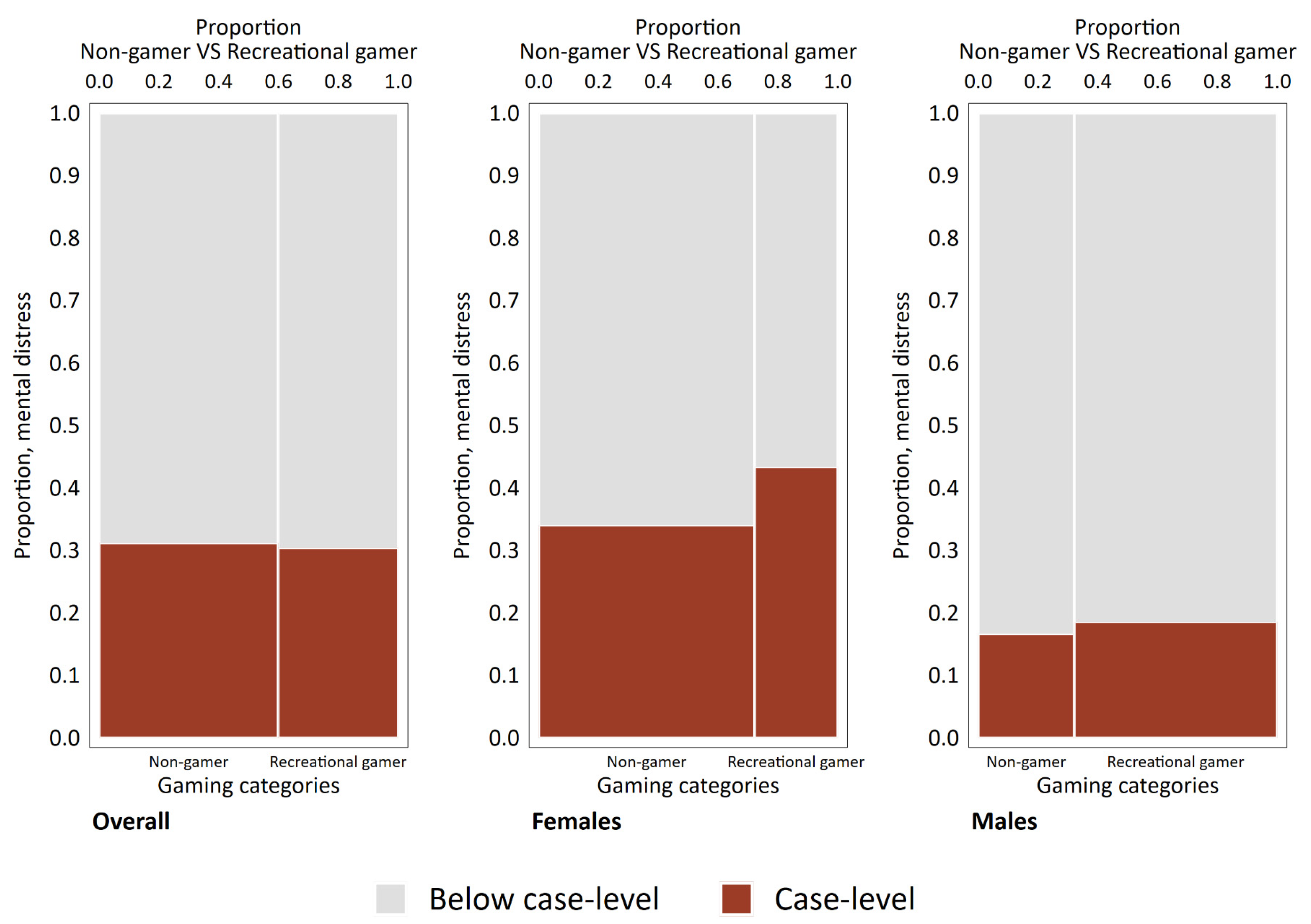
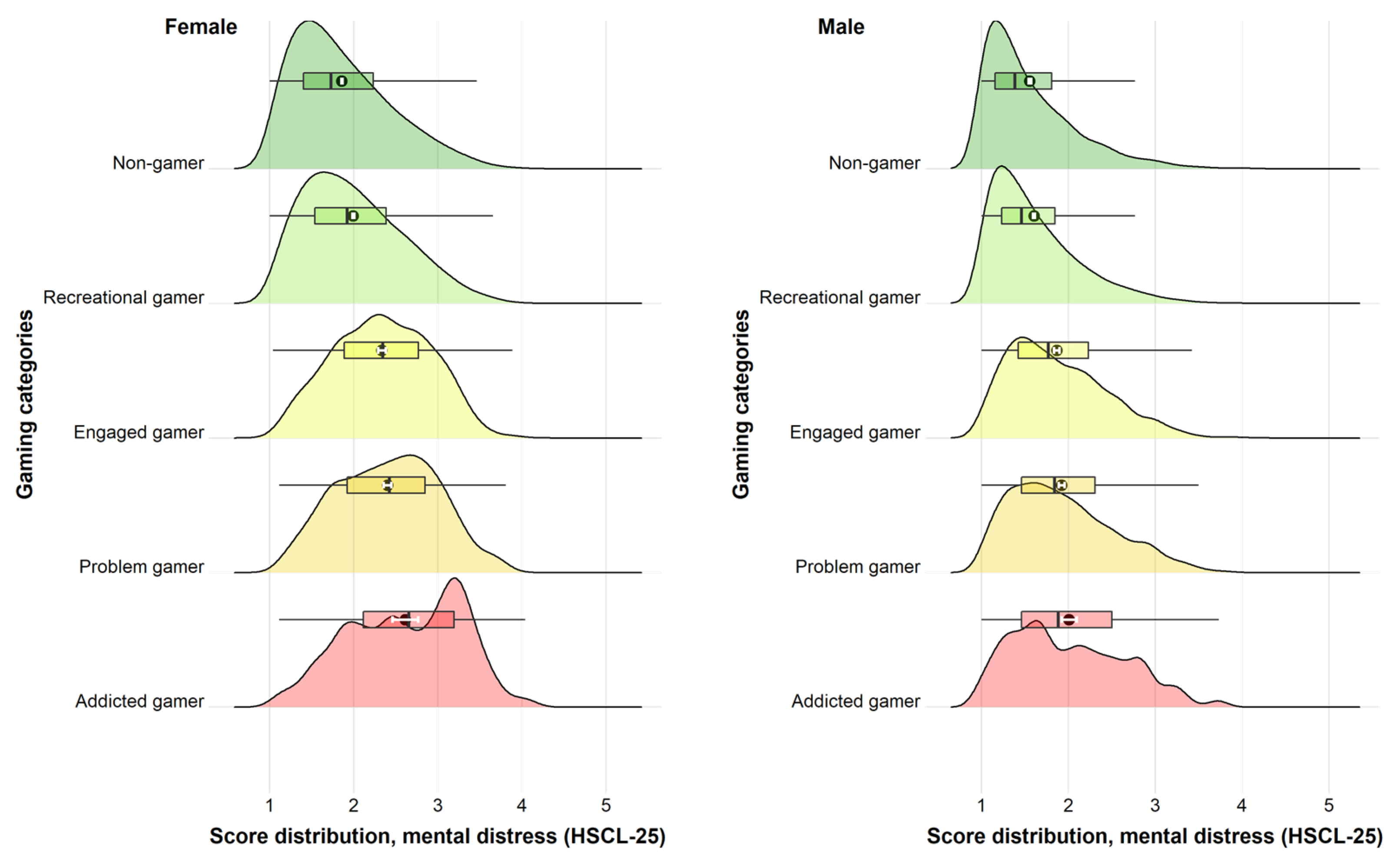
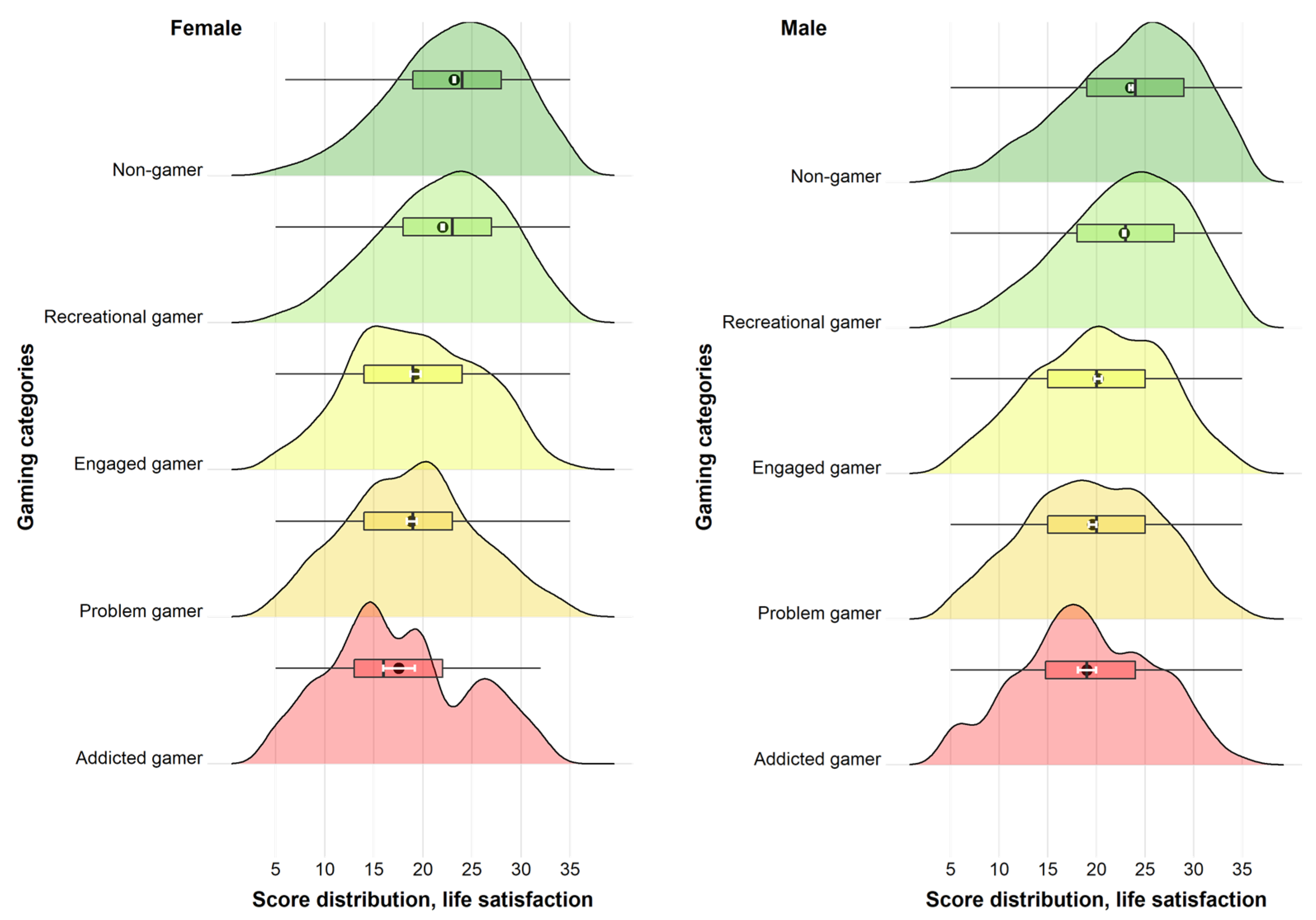
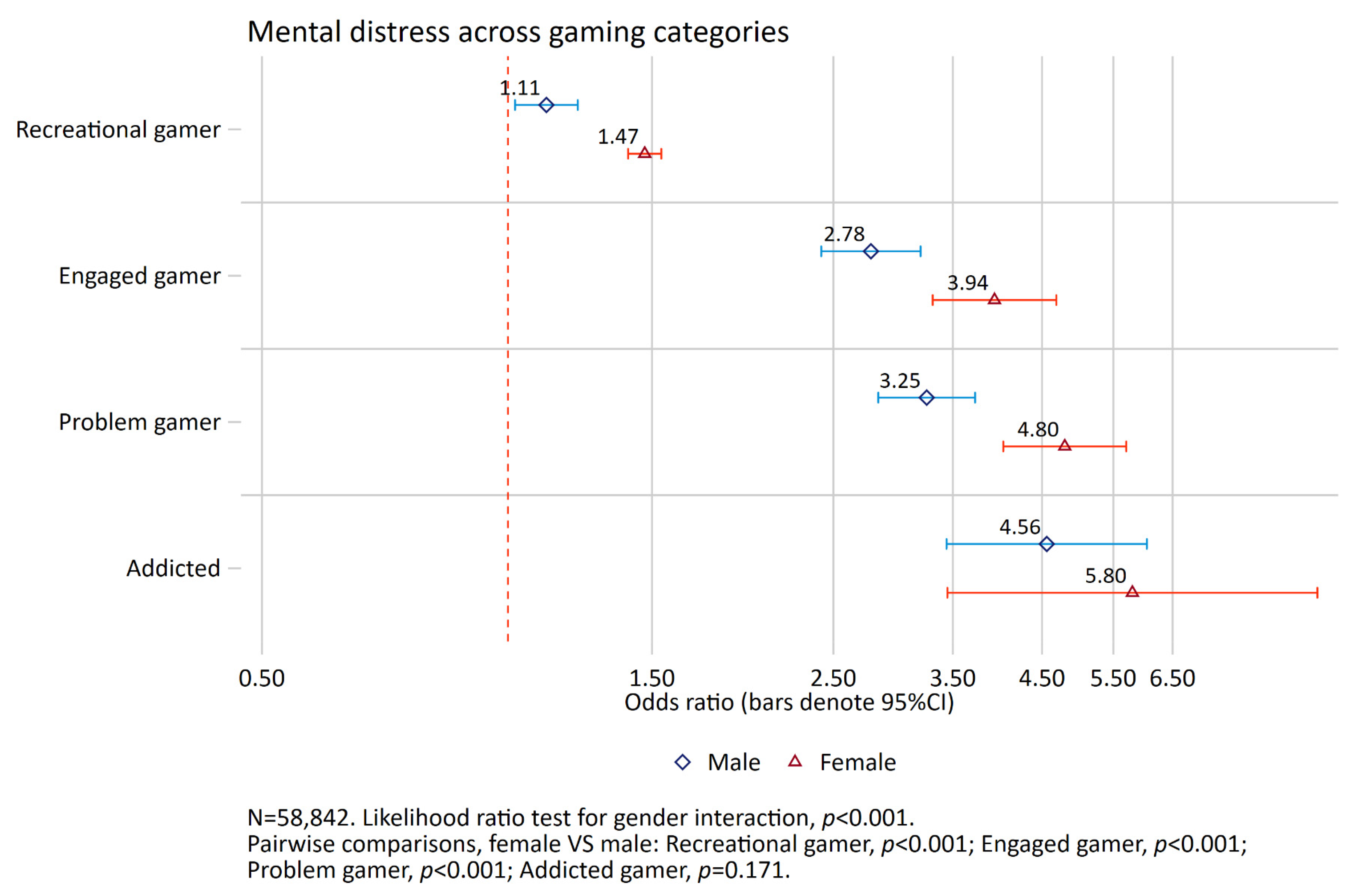
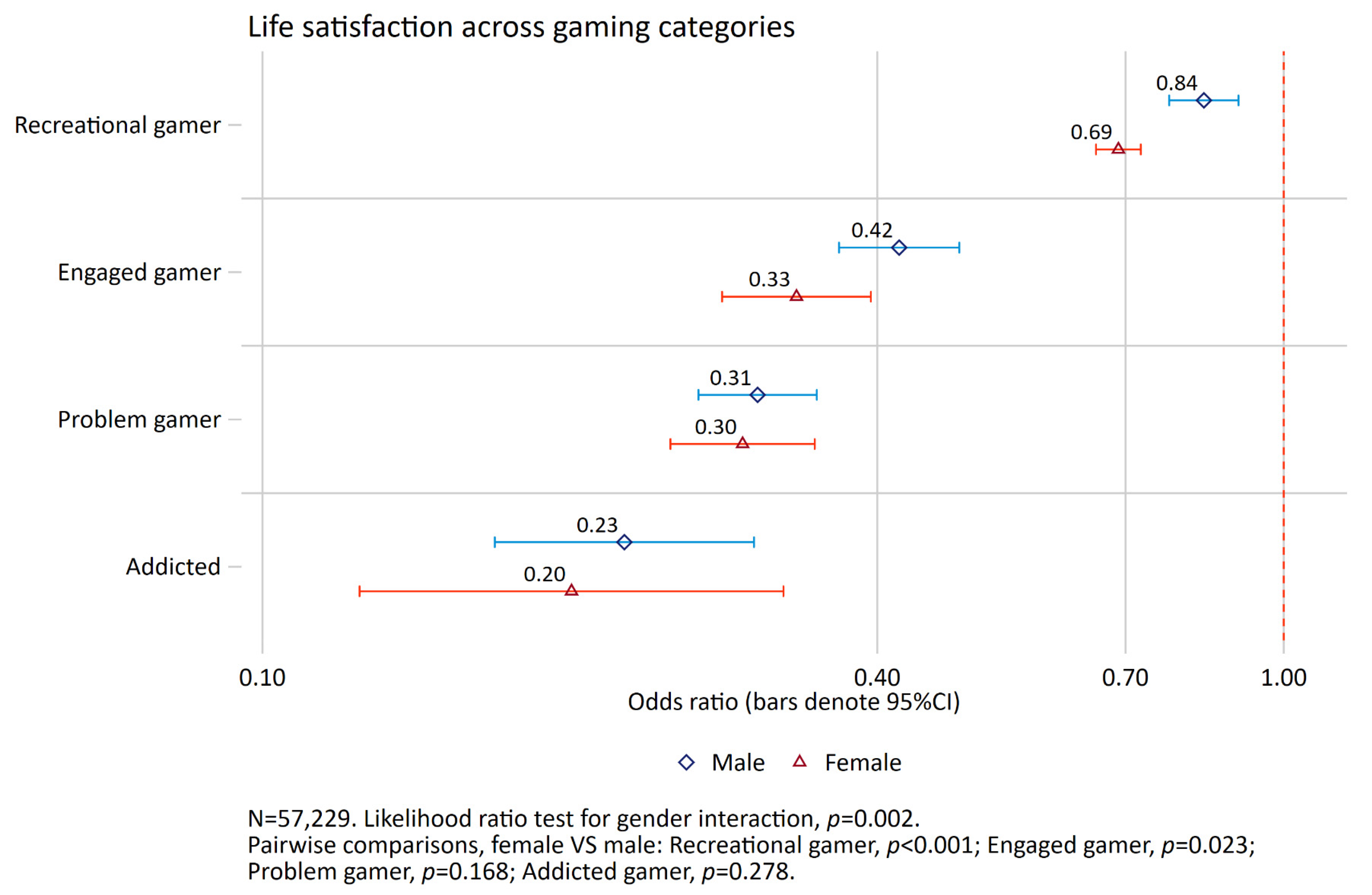
| Characteristic | Non-Gamer, N = 32,811 1 (55.7%) | Recreational Gamer, N = 22,013 1 (37.4%) | Engaged Gamer, N = 1838 1 (3.1%) | Problem Gamer, N = 1954 1 (3.3%) | Addicted Gamer, N = 294 1 (0.5%) | p-Value 2 |
|---|---|---|---|---|---|---|
| Gender | <0.001 | |||||
| Female | 27,381 (70%) | 10,542 (27%) | 610 (1.6%) | 657 (1.7%) | 78 (0.2%) | |
| Male | 5430 (28%) | 11,471 (58%) | 1228 (6.3%) | 1297 (6.6%) | 216 (1.1%) | |
| Age categories | <0.001 | |||||
| 18–20 yrs | 4691 (56%) | 3109 (37%) | 273 (3.3%) | 272 (3.2%) | 39 (0.5%) | |
| 21–22 yrs | 8859 (55%) | 6065 (38%) | 488 (3.0%) | 548 (3.4%) | 76 (0.5%) | |
| 23–25 yrs | 9158 (53%) | 6858 (40%) | 638 (3.7%) | 604 (3.5%) | 89 (0.5%) | |
| 26–28 yrs | 3205 (50%) | 2614 (41%) | 250 (3.9%) | 250 (3.9%) | 46 (0.7%) | |
| 29–35 yrs | 2867 (56%) | 1884 (37%) | 150 (2.9%) | 186 (3.6%) | 36 (0.7%) | |
| 36+ yrs | 4031 (71%) | 1481 (26%) | 39 (0.7%) | 94 (1.7%) | 8 (0.1%) | |
| Relationship status | <0.001 | |||||
| Single | 15,710 (56%) | 10,616 (38%) | 957 (3.4%) | 838 (3.0%) | 107 (0.4%) | |
| Boyfriend/girlfriend | 6831 (55%) | 4691 (38%) | 394 (3.2%) | 445 (3.6%) | 72 (0.6%) | |
| Cohabitant/married/registered partner | 10,194 (56%) | 6654 (37%) | 483 (2.7%) | 666 (3.7%) | 114 (0.6%) | |
| Living arrangements | <0.001 | |||||
| Alone | 6730 (57%) | 4363 (37%) | 402 (3.4%) | 373 (3.1%) | 38 (0.3%) | |
| With partner | 10,337 (56%) | 6719 (37%) | 498 (2.7%) | 662 (3.6%) | 131 (0.7%) | |
| With friends/others in a collective | 13,343 (56%) | 8958 (38%) | 713 (3.0%) | 673 (2.8%) | 88 (0.4%) | |
| With parents | 2199 (48%) | 1886 (41%) | 221 (4.8%) | 241 (5.3%) | 37 (0.8%) |
| Characteristic | Non-Gamer, | Recreational Gamer, | Engaged Gamer, | Problem Gamer, | Addicted Gamer, | p-Value 2 |
|---|---|---|---|---|---|---|
| N = 32,811 1 | N = 22,013 1 | N = 1838 1 | N = 1954 1 | N = 294 1 | ||
| HSCL 3, mean score | 1.81 (0.58) | 1.79 (0.58) | 2.02 (0.60) | 2.08 (0.63) | 2.17 (0.71) | <0.001 |
| Mental distress | <0.001 | |||||
| Below case-level | 22,544 (69%) | 15,301 (70%) | 971 (53%) | 983 (50%) | 136 (46%) | |
| Case-level (>2.0) | 10,221 (31%) | 6694 (30%) | 866 (47%) | 970 (50%) | 158 (54%) | |
| Life satisfaction, score | 23 (6) | 22 (6) | 20 (7) | 19 (7) | 19 (7) | <0.001 |
| Life satisfaction | <0.001 | |||||
| Poor life satisfaction | 8593 (27%) | 6738 (31%) | 847 (47%) | 968 (51%) | 161 (57%) | |
| Good life satisfaction (ref.) | 23,236 (73%) | 14,681 (69%) | 952 (53%) | 933 (49%) | 122 (43%) |
Publisher’s Note: MDPI stays neutral with regard to jurisdictional claims in published maps and institutional affiliations. |
© 2022 by the authors. Licensee MDPI, Basel, Switzerland. This article is an open access article distributed under the terms and conditions of the Creative Commons Attribution (CC BY) license (https://creativecommons.org/licenses/by/4.0/).
Share and Cite
Finserås, T.R.; Sivertsen, B.; Pallesen, S.; Leino, T.; Mentzoni, R.A.; Skogen, J.C. Different Typologies of Gamers Are Associated with Mental Health: Are Students DOOMed? Int. J. Environ. Res. Public Health 2022, 19, 15058. https://doi.org/10.3390/ijerph192215058
Finserås TR, Sivertsen B, Pallesen S, Leino T, Mentzoni RA, Skogen JC. Different Typologies of Gamers Are Associated with Mental Health: Are Students DOOMed? International Journal of Environmental Research and Public Health. 2022; 19(22):15058. https://doi.org/10.3390/ijerph192215058
Chicago/Turabian StyleFinserås, Turi Reiten, Børge Sivertsen, Ståle Pallesen, Tony Leino, Rune Aune Mentzoni, and Jens Christoffer Skogen. 2022. "Different Typologies of Gamers Are Associated with Mental Health: Are Students DOOMed?" International Journal of Environmental Research and Public Health 19, no. 22: 15058. https://doi.org/10.3390/ijerph192215058





